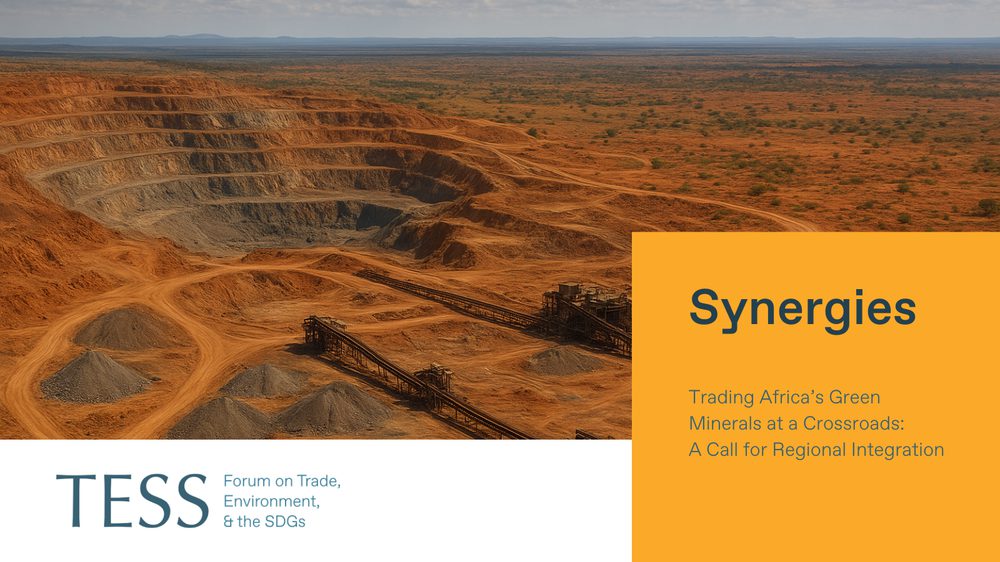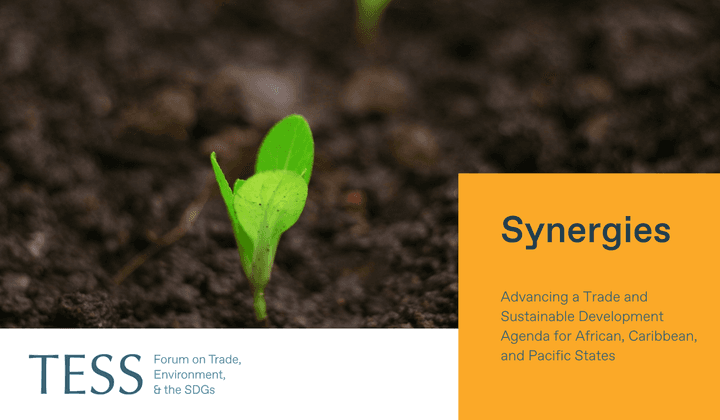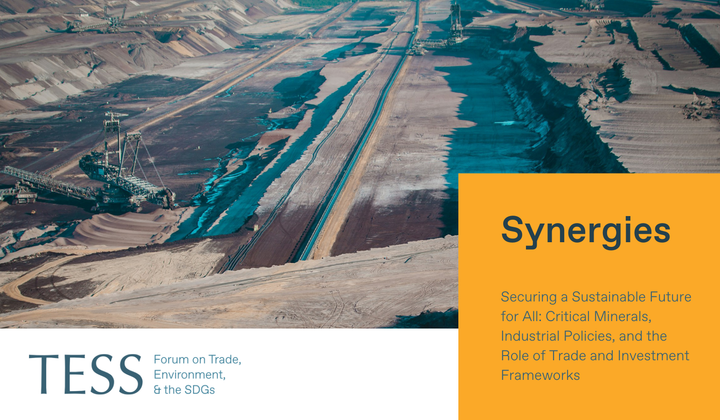Africa's critical minerals offer more than a path to economic development and diversification—they present a historic opportunity to recalibrate the continent's role in global trade, climate action, and green industrialization. African countries should aim to leverage growing competition among their international partners to unlock expanded development opportunities across the continent. To achieve this, it is urgent to shift to a concerted and purposeful regional approach to trade diplomacy in green critical minerals.
This article is part of a Synergies series on climate and trade curated by TESS titled Addressing the Climate Crisis and Supporting Climate-Resilient Development: Where Can the Trading System Contribute? Any views and opinions expressed are those of the author(s) and do not necessarily reflect those of TESS or any of its partner organizations or funders.
-----

In the race to triple renewable energy capacities by 2030, the global demand for critical minerals is surging. Copper, cobalt, nickel, lithium, rare earth elements, and platinum group metals are essential to renewable energy systems, electric vehicles (EVs), green hydrogen, and other technologies that enable decarbonization. The International Energy Agency predicts that EVs and their associated production of batteries will be responsible for about half of the demand growth for critical minerals over the next two decades. Africa is home to over 30% of the world’s known reserves of these minerals, and numerous major economies are competing to secure access to the continent’s reserves (see here, here, and here).
Harnessing the Surge: Africa’s Trade Dilemma in a New Era of Critical Minerals
In their quest to secure access to critical minerals to meet a range of net zero, national security, and competitiveness priorities, major economies are deploying a range of diplomatic strategies and types of economic arrangements with African countries. The United States, for instance, has signed a joint Memorandum of Understanding (MoU) with the Democratic Republic of the Congo (DRC) and Zambia for the development of value chains for battery-grade materials and is seeking to deepen its cooperation on minerals supply with other African countries through its Minerals Security Partnership Forum. The European Union has also signed separate MoUs with the DRC and Zambia and is exploring Critical Raw Materials partnerships with a number of African countries framed under its Global Gateway Initiative, with a focus on securing supply and improving governance and sustainability. The EU has also introduced a new trade approach in the form of Clean Trade and Investment Partnerships, through which it seeks partnerships on critical minerals supply and green energy transition, and has initiated talks on this with South Africa.
In addition, China, long a dominant player in Africa's mining sector, continues to secure off-take agreements and infrastructure-for-resources deals, especially in the cobalt-rich DRC and in lithium projects in Zimbabwe. Further, Saudi Arabia and other Arab Gulf countries have also stepped up their engagement with resource-rich African countries to secure access to critical minerals for renewable energy projects.
Together, these developments underscore that the African continent finds itself at a critical juncture: poised between continuing to be locked into raw materials extraction and realizing the transformative sustainable development opportunities available from a green industrial revolution. The opportunities for African development cannot be confined to supplying critical minerals to support producers of value-added products outside the continent, but must involve developing regional and extended value chains that are capable of transforming Africa into a hub for green industrialization and supporting regional economic diversification.
These developments underscore that the African continent finds itself at a critical juncture: poised between continuing to be locked into raw materials extraction and realizing the transformative sustainable development opportunities available from a green industrial revolution.
Zooming In: Institutional Coordination and the Africa Green Minerals Strategy
At the institutional level, Africa has made commendable progress in articulating a shared vision for leveraging the continent’s mineral endowment as a tool to support green industrialization. Africa’s Green Minerals Strategy (AGMS), developed by the African Union's African Minerals Development Centre, in collaboration with the African Development Bank, United Nations Economic Commission for Africa (UNECA), and African Legal Support Facility, serves as a blueprint for harnessing Africa's mineral wealth to advance sustainable development, value addition, and climate goals. It builds on the Africa Mining Vision, adopted in 2009, which aligns mineral development with the continent's aspirations for structural transformation.
The AGMS identifies shared priorities at both national and regional levels, including responsible sourcing, beneficiation, value addition, use of local content, harmonization of regulatory frameworks, and capacity building. It calls for integrated planning of infrastructure and regional industrial corridors to support mineral processing and green manufacturing. Moreover, the strategy highlights the importance of cross-cutting issues such as gender inclusion, the role of artisanal and small-scale mining, and environmental sustainability. These recommendations were echoed in the seven principles and five actionable recommendations of the 2024 UN Secretary-General’s Panel on Critical Energy Transition Minerals.
Adopted in February 2025, the implementation of the AGMS is still in its infancy. While some African countries and Regional Economic Communities (RECs) have begun aligning their national mineral strategies with the AGMS, there is still no consolidated platform for collective engagement with external actors. This results in fragmented negotiations with both governments and the private sector, which may weaken Africa's leverage on critical issues, including technology transfer, mineral pricing, and commitments for beneficiation and value addition.
To overcome this challenge, Africa needs a regionally coordinated approach or strategy for external engagement on critical green minerals, built around the AGMS. Central to such a strategy could be a shared negotiating framework for supply agreements and investment arrangements to promote value addition, effective legal instruments with harmonized approaches, co-development and affordable access to needed technologies, establishment of required infrastructure, and advancement of social and economic development for local communities.
A Way Forward: Coordinated Approach to External Engagement on Critical Green Minerals
To ensure Africa’s green minerals benefit the continent first, a clear set of regional principles for external engagement is needed—anchored in transparency, shared benefits, value retention and addition, environmental justice, and technology transfer. These principles agreed upon by African countries, particularly resource-intensive countries, can serve as a framework in bilateral, regional, and multilateral negotiations on critical green minerals. Africa should adopt a common stance on value addition, benefit sharing, pricing models, contract terms, traceability, and ESG standards—ensuring no African country is isolated in its agreements. Drawing lessons from OPEC's collective approach to oil governance, an African platform for critical green minerals diplomacy can enhance negotiation power, avoid underpricing, and align external partnerships with the continent’s industrialization goals.
To ensure Africa’s green minerals benefit the continent first, a clear set of regional principles for external engagement is needed.
From a vision and strategy perspective, the Africa Mining Vision and the AGMS already provide policy alignment. What is needed now, however, is a fast-tracked coordination and implementation mechanism that leverages existing bodies. The African Union Commission, the African Continental Free Trade Agreement (AfCFTA Secretariat, UNECA, and other relevant institutions can co-host a continental coordination task force on green mineral diplomacy. Through the AfCFTA and RECs, African states can define minimum negotiation standards and incentives for responsible investors, harmonize ESG standards, and promote regional mineral corridors. Institutions such as the African Development Bank, Afreximbank, and the African Legal Support Facility can support these efforts through policy coordination, investment de-risking, and industrial policy innovation.
These institutions and coordination efforts should be actively engaged with and informed by communities of practice across the continent. A pan-African critical minerals negotiations advisory group—comprising miners, trade policy experts, trade lawyers, industrial policy experts, and ESG specialists—could be established to offer member countries’ negotiators strategic insights on relevant stakeholder needs and concerns, as well as emerging global and regional trends in green minerals value chains.
Conclusion: Reclaiming the Narrative
It is urgent to shift from fragmented national engagements with powerful global players to a concerted and purposeful regional approach to trade diplomacy in green critical minerals.
Africa's critical minerals offer more than a path to economic development and diversification—they present a historic opportunity to recalibrate the continent's role in global trade, climate action, and green industrialization. African countries should aim to leverage growing competition among their international partners to unlock expanded development opportunities across the continent. To achieve this, it is urgent to shift from fragmented national engagements with powerful global players to a concerted and purposeful regional approach to trade diplomacy in green critical minerals.
The AGMS provides a foundation. What is needed now is collective ambition, institutional innovation, and an empowered African-led knowledge community.
* This article is a slightly adapted version of a thought piece prepared by the authors for the Remaking Trade Project subsequent to the conference "Reimagining Cooperation on Trade and Sustainability: An African Perspective" hosted by the Nelson Mandela School of Public Governance in May 2025.
----------
Marit Y. Kitaw is Economic Affairs Officer, Minerals Sector Lead, Climate Change, Food Security, Natural Resources Division (CFND), United Nations Economic Commission for Africa (UNECA).
Yasmin Ismail is Senior Policy Advisor, TESS.
-----
Synergies by TESS is a blog dedicated to promoting inclusive policy dialogue at the intersection of trade, environment, and sustainable development, drawing on perspectives from a range of experts from around the globe. The editor is Fabrice Lehmann.
Disclaimer
Any views and opinions expressed on Synergies are those of the author(s) and do not necessarily reflect those of TESS or any of its partner organizations or funders.
License
All of the content on Synergies is licensed under a Creative Commons Attribution-NonCommercial-ShareAlike 4.0 International (CC BY-NC-SA 4.0) license. This means you are welcome to adapt, copy, and share it on your platforms with attribution to the source and author(s), but not for commercial purposes. You must also share it under the same CC BY-NC-SA 4.0 license.
If you would like to reuse any material published here or if you have any other question related to Synergies, send an email to fabrice.lehmann@graduateinstitute.ch.





